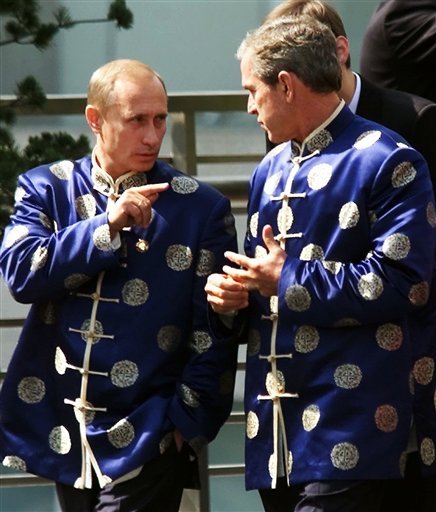Eyes on whether APEC leaders will don aloha shirts

FILE - Russian President Vladimir Putin, left, and President George W. Bush wear traditional silk jackets as they make their way to a family photo session during an APEC leaders summit in Shanghai, China in this October 2001, file photo. This year, Asia-Pacific Economic Cooperation leaders are gathering in Honolulu, inspiring visions of leaders in aloha shirts. But it's not clear if APEC leaders will observe the custom this time around. (AP Photo/The Canadian Press, Fred Chartrand)
Heads of state posing for photos in the traditional attire of the host nation represent one of the most distinct and memorable attributes of the Asia-Pacific Economic Cooperation summit held each year. In Chile, presidents and prime ministers donned flowing ponchos. In Vietnam, it was silk tunics.
This year, 21 leaders are gathering in Honolulu, inspiring visions of Chinese President Hu Jintao and President Barack Obama in aloha shirts. But it’s not clear if APEC leaders will observe the custom this time as the White House remains mum on the issue.
The attire has been the subject of great speculation in the state as locals are anxious to see if world leaders will celebrate a unique Hawaii tradition. Colorful and floral aloha shirts aren’t just standard wear for both work and play in Hawaii — they’re a symbol of the state’s rich multicultural history.
Obama himself stoked speculation when he announced two years ago that he would host the 2011 meeting in the city of his birth. The event started this week, and most of the world leaders begin arriving Thursday.
"I look forward to seeing you all decked out in flowered shirts and grass skirts," he told his counterparts, who that year wore red or blue-gray silk tunic shirts with mandarin collars in Singapore.
The White House hasn’t disclosed what it plans to ask delegates to wear for Sunday’s group photo, and didn’t response to request for comment.
Don't miss out on what's happening!
Stay in touch with breaking news, as it happens, conveniently in your email inbox. It's FREE!
It would seem like a golden and rare opportunity for the conference to grab the attention of people around the world and for tourism-dependent Hawaii to market itself.
But last year, the host nation Japan skipped the ritual for the first time. Officials cited a tight schedule, and said tight-fitting traditional kimonos might not be suitable for a photo session. The leaders instead wore jackets, slacks, and shirts without neckties to their photo.
DeSoto Brown, historian and co-author of the book "The Art of the Aloha Shirt," said it would be disappointing if APEC leaders didn’t wear Hawaii’s signature garb at the meeting.
Brown said he could see that some people might view aloha shirts as not serious or businesslike because they’re often associated with people being on vacation. But he noted that in Hawaii, they’re worn everyday by high-level businessmen.
"Aloha shirts are truly from Hawaii. They were invented here, and are known worldwide," Brown said in an e-mail . He added: "And since President Obama is from Hawaii, it would be even more appropriate that everyone at APEC should have their photo taken wearing what he is already very familiar with."
There is precedent for world leaders going local in Hawaii. President Bill Clinton sported a baby blue aloha shirt with pink flowers to give a speech in Waikiki in 1993. Hu wore a brown and green patterned one to a luncheon with Hawaii’s governor when he stopped in Honolulu as China’s vice president in 2002. Shortly after winning the Republican nomination for president in 1960, Richard Nixon campaigned in Hilo while wearing a hibiscus flower aloha shirt.
The APEC tradition began in 1993, when Clinton handed out bomber jackets for leaders to wear in their commemorative group photo in Seattle.
Some leaders have appeared visibly uncomfortable in their chosen costume over the years.
Japanese Prime Minister Junichiro Koizumi kept smoothing out his royal blue jacket as he stepped out of his limo at the APEC summit in Shanghai in 2001. And he continued to adjust the jacket while posing for photos with Chinese President Jiang Zemin.
But dressing in unfamiliar clothes can also break the ice.
In Hanoi, a normally dour and somber-faced Hu beamed while posing for photos in an ankle-length Vietnamese tunic in 2006. Russian President Vladimir Putin joked cordially with President George W. Bush.
In Honolulu, having Pacific Rim leaders in aloha shirts would offer a chance for Hawaii to showcase a product that uniquely blends the cultures of its many immigrant groups.
Aloha shirt designs carry influences from paeru wraparound garments worn in Tahiti, colorful Japanese fabrics, and patterns on kapa cloth, a traditional Hawaiian material made from the bark of wauke or mulberry trees.
Aloha shirts first emerged in Hawaii in the 1930s, though it’s not known who made the first one. By the 1960s, they became accepted business wear in the islands. In Hawaii today, the only people who wear a coat and tie are generally first-time visitors and lawyers who have to appear in court.



